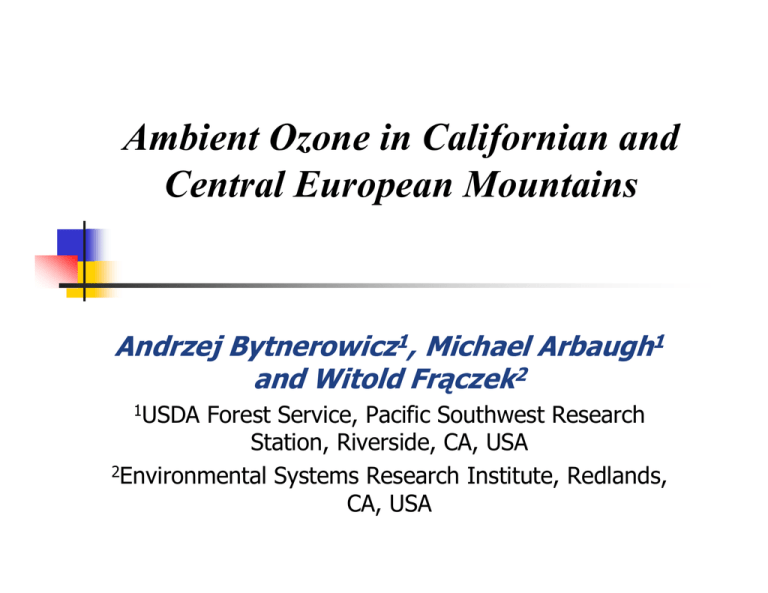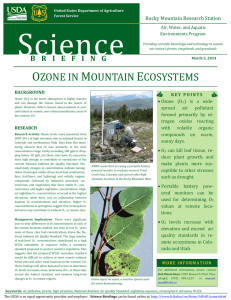Ambient Ozone in Californian and Central European Mountains Andrzej Bytnerowicz , Michael Arbaugh
advertisement

Ambient Ozone in Californian and Central European Mountains Andrzej Bytnerowicz1, Michael Arbaugh1 and Witold Frączek2 1USDA Forest Service, Pacific Southwest Research Station, Riverside, CA, USA 2Environmental Systems Research Institute, Redlands, CA, USA Why ozone? Ambient concentrations have been rising since 1880s Criteria pollutant toxic to humans and vegetation Levels of >30-40 ppb potentially toxic to plants (NRC – need for ecologically-oriented ozone secondary standard) By 2050 ~60% of N. Hemisphere forests will be affected by ambient ozone Background O3 concentrations In a global and regional perspective, the background region for atmospheric pollutants is referred to as the area where the atmosphere is not directly influenced by local and anthropogenic sources. Such regions are limited due to extensive human activities in most of the continental areas and possible background may be limited to the central Pacific, Middle Atlantic and central Eurasia (Pochanart et al., 2003). Continental background concentrations of ozone, annual averages - 1 Location Concentration (ppb) Reference Asia Mondy Mt (China) 43.5 Pochanart et al., 2003 Happo (Japan) 44.4 Pochanart et al., 2004 Mt. Abu (India) 48.1 Naja et al., 2003 37 - 46 Vingarzan, 2004 33.4 Naja et al., 2003 Pacific Mauna Loa (Hawaii) Indian Ocean Mt. Abu data Continental background concentrations of ozone, annual averages - 2 Location Concentration (ppb) Reference Europe Finland 30 Laurila & Lattila, 1994 Arosa, Swiss Alp 35 Pochanart et al., 2001 North America US, inland 25 - 45 Altshuller & Lefohn, 1996 US, coastal 25 - 35 Ibidem US, East 15 - 30 Liang et al., 1998 US, West 25 - 35 Ibidem Canada 23 - 34 Vingarzan, 2004 CASTNET - Annual Mean O3 Concentrations (ppb) for 2002 CASTNET- Peak SUM06 Values (ppm-hr) for 2002 Our approach to characterizing air pollution status in mountain terrain Use of reliable, easy to use passive samplers allowing for monitoring air pollutants in remote areas where electronic monitors cannot be used In selected location, collocation of portable UV absorption real-time monitors Development of maps of ozone distribution with geostatistical models Ogawa Passive Sampler Passive samplers for O3 and HNO3 vapor in Sierra Nevada Advantages of using passive samplers Low cost Simple design and operation Low maintenance needs No need for electric power Possibility for dense deployment Reliable results Integration of long-term exposure regimes Limitations of passive samplers No information on diurnal, real-time concentrations (needed for understanding toxic potential) Changes in climatic conditions (wind, temperature, RH) affect samplers’ performance Need for calibration against real-time monitors ESRI Geostatistical Analyst Extension of ARC/INFO 8 generates predictive surfaces from data points using geostatistical tools and analyzing error of the resulting estimations. Numerous kriging and predictive tools are the center of the extension. Ozone distribution in the Sierra Nevada - 1999 Mountains as barriers for air pollution transport – 2002 studies Hypothesis 1. River valleys are natural corridors for moving pollutants across mountain ranges. Hypothesis 2. High mountain ranges may be very effective barriers preventing long-range transport of polluted air masses. 2002 intensive studies – Lake Tahoe and the San Joaquin River transect M am ne y a ak nc h hi m O la O tn ek Pe ak ss re Pa C re ek ut AR L ek M ok o C Lo tn ak e Cr e SN sh op 39 5 M re ek rL C e e re om Ac ot h in m er w Bi C h ek Po ol D at tl ea th e am Sh M kw Fi s C ua w al f ot h H m se r e ry Ba Cr e ho u oc k el ls am R er It a lia n ak be r rL Au ng e Po w ed i Sq H M ot h St ar m R ppb Ozone on the San Joaquin River transect in summer 2002 Ozone seasonal averages 100 90 80 70 60 50 40 30 20 10 0 Lake Tahoe air pollution monitoring – summer 2002 hours 305 297 289 281 273 265 257 249 241 233 225 217 209 201 193 185 177 169 161 153 145 137 129 121 113 105 97 89 81 73 65 57 49 41 33 25 17 9 1 ozone (ppb) 2B Technology Monitor Real-time Ozone Data Fenced Meadow, 7/23/15:45 - 8/5/14:00/2003 120 100 80 60 40 20 0 Locations of the 32 Measurements Sites Air quality in the Tatra Mountains is affected by transport of polluted air masses from many European countries Distribution of ozone in complex mountain terrain is difficult to predict Information on ozone levels helps to understand risks to sensitive plants such as ponderosa pine or Swiss stone pine Elevated levels of ozone predispose trees to drought stress and insect attacks Conclusions - 1 North America and European mountains experience elevated levels of tropospheric O3 potentially toxic to humans and vegetation Long-range transport, including trans-Pacific transport from Asia, is responsible for significant increases of ambient O3 levels Better understanding of temporal and spatial distribution of O3 in western mountains is needed Conclusions - 2 Polluted air masses can move across mountain ranges along river valleys (example - San Joaquin River drainage). Mountain ranges can prevent movement of polluted air masses acting as pollution barriers (example – Desolation Wilderness west of Lake Tahoe) Conclusions - 3 Forest fires are important sources of VOCs and NOx and promote O3 formation Passive sampler networks can effectively point to “hot spots” for ambient O3 and other pollutants There is a need for “translating” long-term average O3 concentrations into real-time values (models are already available) Thank you !!!







